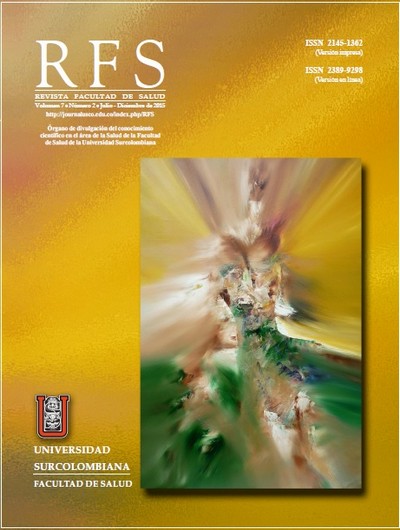How salaries change among health professions in Huila, 2013
##plugins.themes.bootstrap3.article.main##
Introduction. According to the Constitutional Court, remuneration for services rendered is a worker's basic right. Salaries should be appropriate for the effort, preparation, experience, knowledge and time commitment put in. Objective. Evaluate the salaries of health professions. Method. A descriptive, quantitative and transversal study, using a sample of 1060 health professionals in six health institutions in Huila. Information was collected using a survey administered by the researchers, processed using Excel 2013 and results were analysed statistically and descriptively. Results. 60% of the professionals were in the most comprehensive hospital (providing the widest range of care and treatment options); a similar percentage belong to the discipline which has historically been the most important in the health system. The salaries are low, something which is accentuated among women. There are no standardised criteria to determine remuneration. 32.8% have a postgraduate qualification, of whom 91.6% belong to the discipline with greater economic recognition. The monthly salary of the health professionals varied from $2.635.135 to $11.800.000, an average of $5.247.823, median of $5.638.000 and mode of $5.368.000. 27.5% have a permanent contract, 14% have temporary contracts and 58.5% are contracted through unions. Conclusion. There is discrimination and inequality in the distribution and remuneration in health professions. This goes against the call for development of human talent formulated in the Toronto Call to Action. Recommendation. Manage the approval of a balanced and fair salary scale for health care professions.
Downloads
##plugins.themes.bootstrap3.article.details##
Cortés de Téllez R, Ramírez AL, Restrepo MP, Vargas BC. Declaración del Consejo Técnico Nacional de Enfermería “sobre el deterioro de las condiciones laborales del profesional de Enfermería en Colombia” En: encolombia.com. Revista de enfermería. [Internet] Disponible en: http://encolombia.com/medicina/revistas- medicas/enfermeria/vole-134/declaraciondel consejotecnico
Dayrit MM, Dolea C, Dreesch N. Abordando la crisis de los Recursos Humanos para la Salud?: ¿Hasta dónde hemos llegado? ¿Qué podemos esperar lograr al 2015? Rev Peru Med Exp Salud Pública. 2011;28(2): 327-336.
Organización Panamericana de la Salud. LLAMADO A LA ACCIÓN 2006-2015 Hacia una Década de Recursos Humanos en Salud para las Américas. Canada: Toronto 2005. [Internet] Disponible en: http://www. msal.gob.ar/observatorio/images/stories/documentos_ institucional/decada%20de%20rhus/3-4-b-desafios toronto.pdf
Restrepo DA, Ortiz LC. Situación laboral de los profesionales en medicina y enfermería en Colombia: aproximaciones desde el Ingreso Base de Cotización al SGSSS. En: Ministerio de la Protección Social. Dirección General de Análisis y Política de Recursos Humanos. Boletín No. 2. Diciembre de 2010. [Internet] Disponible en: https://www.minsalud.gov.co/Documentos%20y%20Publicaciones/APROXIMACI%C3%93N%20AL%20IBC%20PROFESIONALES%20 EN%20MEDICINA% 20Y%20ENFERMER%C3%8DA.pdf
Arias Dolly. Características de profesionales y auxiliares de enfermería del Huila. 2010. av.enferm. [Internet]. 2012; 30( 2 ): 56-66. Available from: http://www.scielo.org.co/ scielo.php?script=sci_arttext&pid=S0121-45002012000200006&lng=en.
García Roa EM, Tapias Torrado L. EQUIDAD DE GÉNERO EN EL EMPLEO DEL SECTOR SALUD COLOMBIA 2008-2010. Pontificia Universidad Javeriana; 2010. p. 191. [Internet]. Disponible en: http://repository.javeriana.edu.co/bitstream/10554/871/1/pol151.pdf
Colombia. Ministerio de Educación Nacional Decreto 2277 de 1979. 1979; (Septiembre 14). [Internet]. Disponible en: http://www.mineducacion.gov.co/1621/articles-103879_archivo_pdf.pdf
Giraldo ÁF. Atención Primaria en Salud (APS) ¿De regreso al pasado?. Rev. Fac. Nac. Salud Pública 2011. Vol.30 (1): 83-94. [Internet]. Disponible en: http://www.scielo.org.co/pdf/rfnsp/v30n1/v30n1a10
Organización Mundial de la Salud. Informe sobre la salud en el mundo 2006 - Colaboremos por la salud [Internet]. 2006 [cited 2014 May 7]. [Internet]. Disponible en: http://www.who.int/whr/2006/whr06_es.pdf?ua=1
Organización Panamericana de la Salud. Indicadores Básicos 2011 Situación de Salud en Colombia. 2011 [cited 2014 May 26]; [Internet]. Disponible en: http://medcontent.metapress.com/index/A65RM03P4874243N.pdf
Colombia. Ministerio de Salud y Protección Social. Informe de actividades 2012 – 2013 Sector Administrativo de Salud y Protección Social. 2013;1-225. [Internet]. Disponible en: http://www.minsalud.gov.co/Documentos%20y%20Publicaciones/Informe%20al%20Congreso%202012-2013.pdf
Congreso de la República de Colombia. LEY 1438 2011. Retrieved May 07, 2014, [Internet]. Disponible en: http://www.secretariasenado.gov.co/senado/basedoc/ley_1438_2011.htmleyes desde 1992.
Oficina Internacional del Trabajo. Declaracion relativa a los Principios y Derechos Fundamentales en el trabajo. C100 Convenio sobre igualdad de remuneracion, 1951. [Internet]. Disponible en: http://www.ilo.org/wcmsp5/groups/public/—ed_norm/—declaration/documents/publication/wcms_decl_fs_107_es.pdf
Fundación Innovación de la Economía Social. Innoves. Barreras sociales de las mujeres para emprender. Retrieved May 012, 2014 [Internet]. Disponible en: http://www.emprendedorasenred.es/archivos/1331202164-Estudio%20Fempes.pdf
Buchan J, Couper ID, Tangcharoensathien V, Thepannya K, Jaskiewicz W, Perfilieva G, et al. Early implementation of WHO recommendations for the retention of health workers in remote and rural areas. Buul Word Heal Organ. 2013;(May):834-40. [Internet]. Disponible en: http://dx.doi.org/10.2471/BLT.13.119008
Directrices. Incentivos para los profesionales. Prepublicacion. 2008. P. 9-12. [Internet]. Disponible en: http://www.who.int/workforcealliance/documents/Incentives_Guidelines%20SP.pdf










